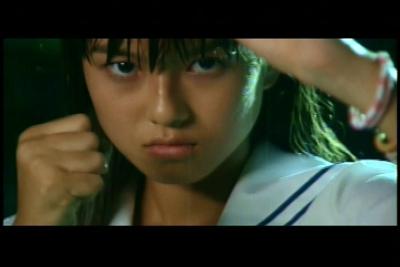Anime schoolgirls are a distinctive breed. Lithe and long-limbed, these sailor-suited sirens are prone to demonic possession, often found with magical powers, and quite likely to be martial artists. Any resemblance to real-Japanese teenagers is purely coincidental. But then again, once in a while someone in the live-action world will wonder – just how difficult would it be to try this kind of story with real girls…?
Ever since she was bullied as a child, Mann (Jun Matsuda) has nurtured her own natural abilities in the martial arts. A few years of living abroad in Hong Kong and Thailand have allowed her to hone her skills in kickboxing, which come in handy on the tough streets of Shinjuku. Well, there’s tough and there’s tough. The bars and accessory shops are hardly mean streets, but it’s still the home turf of gangs of sailor-suited schoolgirls, and they’re fighting over their territory.
Like a latter-day Yojimbo, Mann walks into the middle of the conflict, as four girl-gangs put down their make-up and hairbrushes to duke it out in a surreal conflict. Meanwhile, Shinjuku’s famous talent-scouts lurk in the shadows – earnest young men who claim to work for modelling agencies, feverishly pursuing lookers down the street, and inviting them to come over for a “camera test.”
Based on the 1993 Young Magazine manga by Tetsuya Koshiba, Tennen Shojo Mann was adapted for the TV screen in 1999 by controversial movie director Takashi Miike, who turned it into a cross between the movie Bounce Ko-gals and an episode of Kung Fu. Initially broadcast as three movie-length TV episodes, Tennen Shojo Mann hit Japanese airwaves at the tail-end of the 1990s scandal for enjo kosai or “subsidised dating.” A puritanical crusade against schoolgirl prostitutes that spectacularly backfired when it brought more publicity to the phenomenon than it really warranted, the enjo kosai scandal inspired a number of creators to film their own takes on events. The most famous was Evangelion director Hideaki Anno’s live-action Love and Pop.
But only Takashi Miike, director of cult hits like Audition and The Happiness of the Katakuris, would conceive of approaching his subject as a martial arts comedy, as the feisty Mann punches out any perverts who come her way. Shooting on hand-held DV cameras that allow him to weave in and out of real-life locations, Miike turned Koshiba’s comic into one of the quintessential living manga, despite the potential pitfalls of a low budget, speedy schedule, and a cast of fractious models. It’s a testament to Miike’s skill with the pulp medium that Tennen Shojo Mann isn’t completely unbearable, since under his firm guidance, the film avoids the cheap camera tricks, unnecessary zooms, and overt fan service one could expect from a lesser director. The result is a comedy schoolgirl version of the Godfather trilogy, with, as the Japanese title hints, “made-up girls” instead of “made-men” as the criminal footsoldiers.
Though Tennen Shojo Mann does not take itself as seriously as other underworld dramas, it still portrays a sanitized image of life on the edge of the criminal world—Mann’s friends might act like desperate street kids, but they all seem to have nice middle-class homes to return to at the end of the day. To be fair however, this is at least part of the gag, as demonstrated when two groups of girls greet each other with cheery waves, only to remember they’re supposed to be hanging tough. With sixteen (count ’em!) female leads, all making up in looks what they lack in any discernable acting ability, and noisy wham-bang sound effects laid over Mann’s fights, the show was enough of a success on the Japanese satellite channel WOWOW to lead to a two-part sequel, Tennen Shojo Mann Next. This, however, deviated far from the story of the original manga, pitting Mann and her sailor-suited allies against a model-agency run by vampires.
TSM Next takes the Shibuya lifestyle to extremes, depicting “talent scouts” who are literally interested in sucking the life-blood out of their new recruits, and minor celebrities for whom fame has become a deadly addiction. In one of its best scenes, vampire model Maria (played by real-life cover-girl Shiori) collapses in the middle of a photo-shoot, aging years in mere seconds while her schoolgirl fans look on in horror. She stumbles through the streets as her beauty, her fame, and ultimately her life slip away. Mann (now played by Ayana Sakai) is on hand to act a role inspired more by Buffy than the original comic, but screenwriter Itaru Era makes sure to inject a Romeo and Juliet subplot, when Mann finds herself falling for one of her fanged enemies.
By the time TSM Next was broadcast in November 1999, the enjo kosai fad had faded, and the fickle idol market had moved on (none of the original cast returned for the sequel). The prolific Miike moved on to better things, and has made over a dozen movies since. But fans of living manga can still find the original comic and tapes of the TV show, and add it to their growing files of things that could only have happened in Japan.
(This article originally appeared in Newtype USA, November 2003)


Thanks to you I got to see these, and they were great fun! Back when Miike was still doing stuff I could enjoy…
Sounds like a fun era that left me behind while I was watching quality films like ‘batman forever’ and ‘demolition man.’
As much as I’d like to watch Tennen Shojo Mann I don’t think I’ll get the chance, Amazon have Love & pop on region 1 dvd but I’m not sure I can justify the £24 tag when I could buy Magical Shopping Arcade for the same price.
Sounds like I had to have been there at the time to catch it, much like the time (1999) channel 4 aired a bunch of ‘Pink’ films for their Japanese season like Tandem Starring Ito Takeshi.